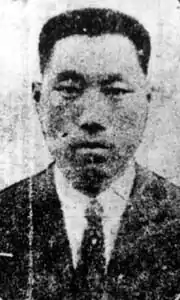Na Seok-ju
Na Seok-ju (February 4, 1892 – December 28, 1926) was a Korean independence activist. He lived during the Japanese colonization of Korea, and joined the Korean Provisional Government in their resistance against the Empire of Japan.
Na Seok-ju | |
|---|---|
 Na Seok-ju | |
| Born | February 4, 1892 |
| Died | December 28, 1926 (aged 34) |
| Cause of death | Suicide by gunshot |
| Known for | Korean independence activist |
| Awards | Order of Merit for National Foundation |
| Korean name | |
| Hangul | |
| Hanja | |
| Revised Romanization | Na Seok-ju |
| McCune–Reischauer | Na Sŏk-chu |
He is most remembered for his attack on the Oriental Development Company, an organization set up by Imperial Japan as part of its imperial expansion and the development of its colonies.[1]
Early life and career
Na Seok-ju was born into on February 4, 1892, in Chaeryong County, Hwanghae Province, Joseon. He grew up in a farming family.[2]
As he got older, he moved to Manchuria in order to receive military training for four years.[3] After completing his training, Na Seok-ju returned to his hometown and worked as the manager of a local store. During this period, Na was also involved in underground political movements against the Japanese colonial rule of Korea; during the March 1st Movement (1919) in occupied Korea, he helped to organize local protest efforts and raise funds for Korean nationalist militant groups.[3]
In 1920 Na Seok-ju was found responsible for killing multiple Japanese authorities, as well as a Korean man believed to be a conspirator with the Japanese,[3] resulting in Na's decision to flee to Shanghai on September 22, 1920, to escape the charges. While in China Na served as a bodyguard for the Provisional Government of Korea, which had been formed in reaction to Japanese suppression of Korean protesters and activists after the March 1 Movement.[4] Na also visited Tianjin while in China in order to meet with Kim Chang-suk, who asked him to blow up the Oriental Development Company, Joseon Bank, and Industrial Bank of Japan buildings upon his return to Korea.[3]
Attack and death
On December 26, 1926, Na Seok-ju travelled south from Manchuria towards Seoul. After using various disguises to get across the Chinese-Korean border and through different checkpoints, Na finally arrived in Seoul on December 28. He first went to the Industrial Bank, where he detonated a grenade near the loan department, destroying it. From there, he made his way to the Oriental Development Company building, where he shot multiple Japanese office workers within the building; Na then attempted to detonate another grenade in order to kill several higher-level employees, but failed when the grenade proved to be a dud. After leaving the second building, Na attempted to escape the premises, killing a Japanese police officer in the process.
Na was pursued by the Japanese police force. In order to avoid being apprehended, Na Seok-ju shot himself three times in the chest, and died later that day after being rushed to hospital.[3]
Legacy
Although some have labelled Na Seok-ju a terrorist for his actions, particularly his attacks on non-military targets, others have celebrated his efforts to liberate colonial-era Korea from its Japanese invaders. Na was given posthumous honors, and acknowledged as a nationalist hero, with a statue of him erected in Seoul.[5][6]
References
- Edwin H. Gragert. Landownership Under Colonial Rule: Korea's Japanese Experience, 1900-1935. University of Hawaiʻi Press, 1994.
- Kim Jinwung. A History of Korea: From "Land of the Morning Calm" to States in Conflict. Indiana University Press, 2012.
- "Movement Activist." Independence Hall. The Independence Hall of Korea. Accessed December 10, 2013.
- ""Korean Provisional Government."". Encyclopædia Britannica. 2013. Retrieved December 11, 2013.
- Julian Bleecker (October 15, 2005). ""Na Sok-Chu."". Flickr. Retrieved December 10, 2013.
- Jonny El (October 24, 2009). ""Patriot Na Sok-Chu."". Flickr. Retrieved December 10, 2013.